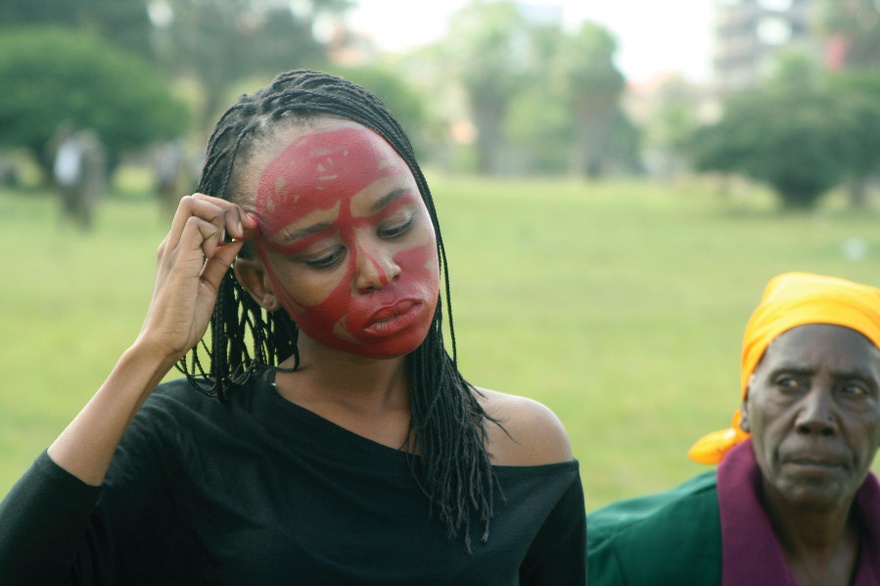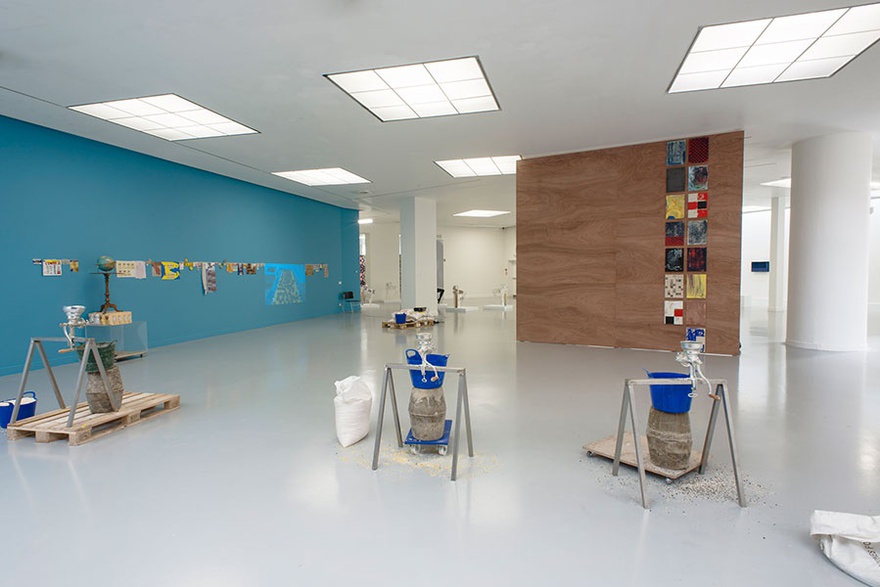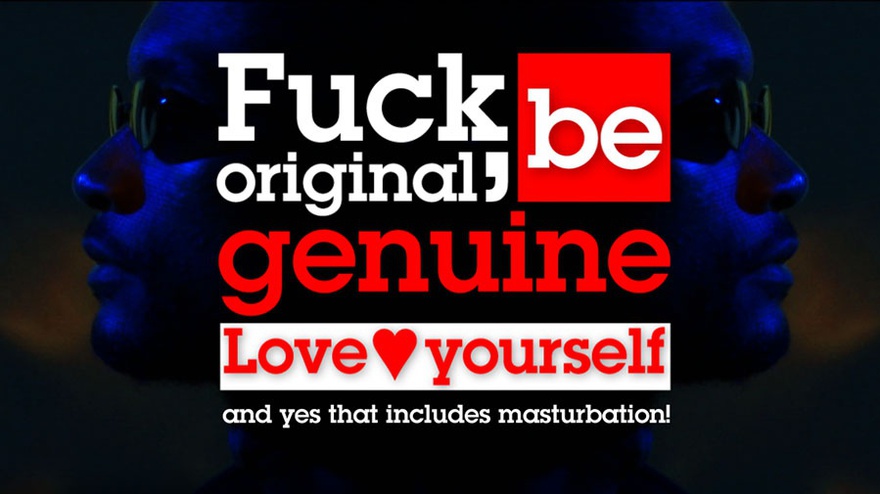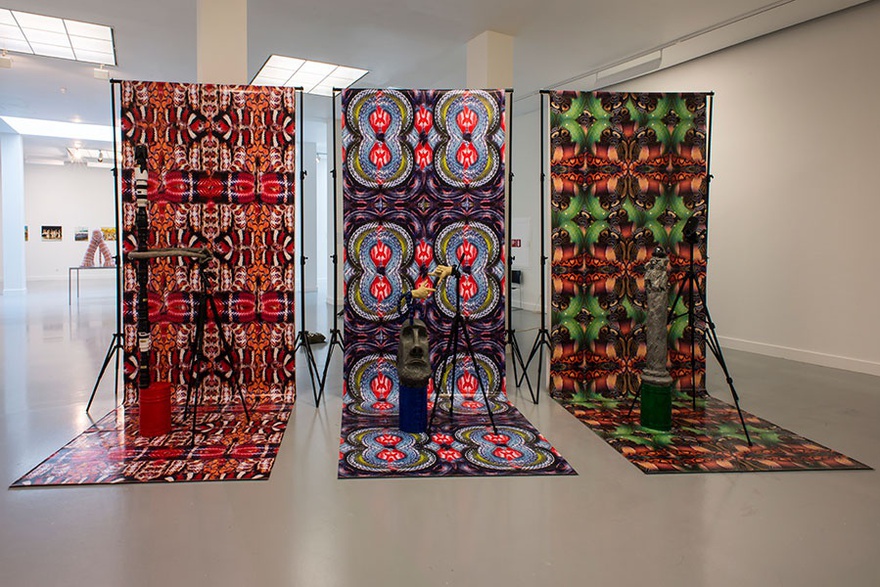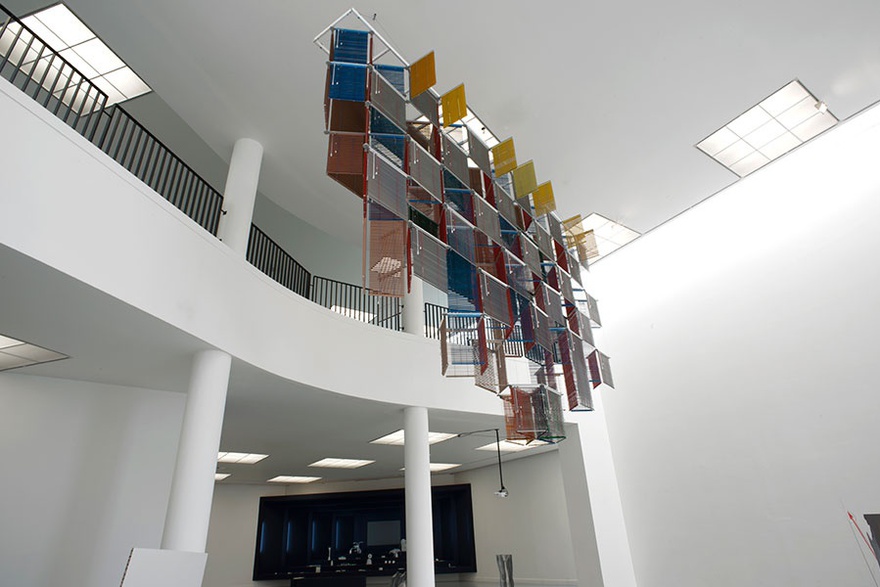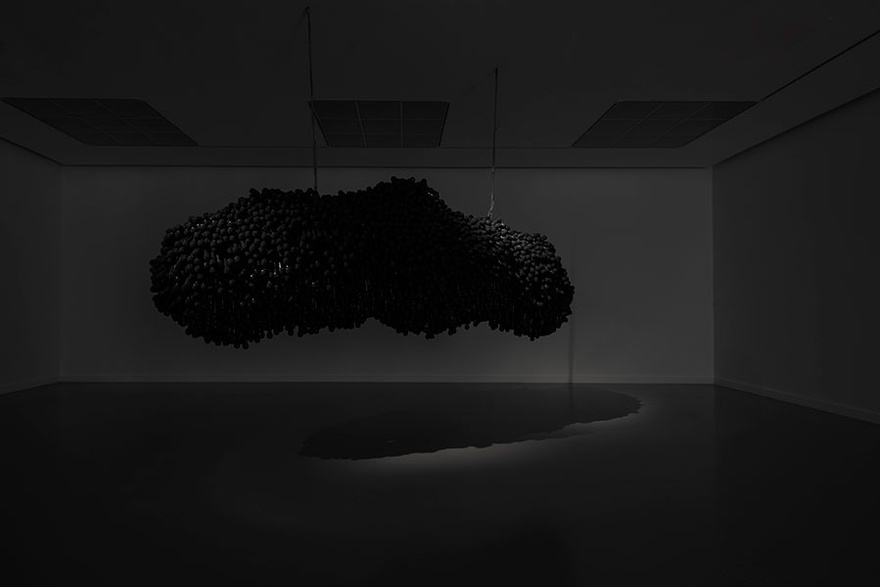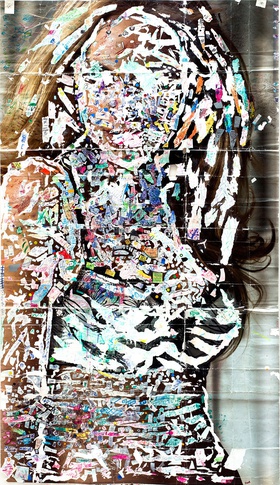Interviews
Art After Identity Politics
Nav Haq in conversation with Stephanie Bailey
Don't You Know Who I Am? Art After Identity Politics is an exhibition organized by the Museum of Contemporary Art Antwerp (M HKA) within the framework of 'The Uses of Art', a project by the European museum confederation L'Internationale, which proposes 'a space for art within a non-hierarchical and decentralized internationalism, based on the value of difference and horizontal exchange among a constellation of cultural agents, locally rooted and globally connected.' Curated by Anders Kreuger and Nav Haq, the exhibition took over both main floors of the M HKA along with an off-site presentation at the Permeke Library in Central Antwerp, and was organized in partnership with AIR Antwerpen, which hosted residencies in Antwerp for a number of the 27 participating artists, who hailed from around the world, including Beijing, Brussels, Cairo, and Lahore to Manila and Moscow. In this interview, curator Nav Haq explains the exhibition's intention, which was to present new generations of artists interrogating 'the formation of identities in the world through strategies such as abstraction, performativity, thingness, the logic and aesthetics of the digital, activism, analysis of selfhood from cultural and scientific perspectives or addressing the role of the viewer.'
Stephanie Bailey: To start, what was the rationale behind the conception of this show and its approach to identity in the twenty-first century?
Nav Haq: This subject is something I've been researching for quite a long time actually. I've been thinking about whether there's something quite fundamentally different in terms of how artists are dealing with questions of identity politics in their work, and I believe there is. It has come about through observations of what artists are doing and, in a certain sense, through my understanding that a lot of artists possess a lot more intelligence than the art system is able to accommodate, particularly when it comes to these questions. When we think about the historic discourse of identity politics in art, there was previously a really important necessity for it, because it was about challenging the supposed universality of modern or contemporary art – for example this idea of the masterpiece somehow being the embodiment of this universal, invisible figure of the bourgeois, heterosexual, white male. I think there was a real necessity to question art's power structures, and a lot of art did. But there were certain issues to do with such an approach in terms of genuine change.
Without wanting to generalize, it was more through strategies of 'making oneself visible' from a perspective of marginalization. We are familiar also with the self-defined constituencies of identity politics – most visibly via race, gender and sexuality. I think that Peggy Phelan spoke really quite eloquently about the situation of identity-based art in the early 90s in her book Unmarked: The Politics of Performance. I think that after a while people began to realize that actually the transition was ultimately only from marginalization outside the art system to ghettoization within the art system. This was because there was a strong level of expectation of what kind of art a marginalized artist should make. In simple terms – if you were a black person in America you'd be expected to make art about being a black person in America. That was the means of legitimizing whether someone could become part of the art world or not. The 'thesis' for this exhibition is to claim that there has been a paradigm shift in how artists might wish to deal with these questions, embedding their practice in a broader notion of complexity, and also readdressing the terms of engagement as mediated by the art world.
SB: That's interesting when thinking about Oscar Murillo's inclusion in the show, given the rise in his reputation and market value, and the controversy that surrounds him as a result. Some lament the description of Murillo as a new 'Basquiat', lambasting him – or his galleries – for using his Colombian heritage as a marketing tool. Others see Murillo's work as an attempt at revealing the structures and dynamics around him when it comes to how the artist works with both collectors and galleries. There was his most recent exhibition at David Zwirner, A Mercantile Novel, for example: an in-gallery Chocmelo candy factory complete with assembly line of 13 workers from his native Colombia. Then there was his residency at the home of the Brazilian collector Frances Reynolds, which culminated during the ArtRio art fair at a party, when Murillo delivered a speech that recalled Brazil's colonization so as to explain what he did during his residency: dress in a white jumpsuit and work as a member of the house staff, who were predominantly black.
In so many ways, Murillo's work is about the actions of an artist who is not so much capitalizing on his identity as much as he is responding to how it is both perceived and how it fits it within the wider frame of the art world and its microcosm of privilege, which links to the wider themes he explores: capitalism and class. As Murillo noted in one interview, 'Any opportunity of artistic achievement comes with an opportunity to infiltrate a social class,' and the work produced especially for this exhibition at M HKA – A Bastard Class (2014) – highlights this by presenting a production site for a functioning factory of ceramic coconuts like those often found in places such as Colombia and Mexico. The installation highlights the globalized nature of production: it includes packaging, from 'Easy Cook Haleem' to 'Sir Edward's Finest Scotch' and even a 'Chinese Heaven Bank Note', used in memorial ceremonies. In this, Murillo's inclusion in this show is refreshing in that it allows the complexity of his approach to come through beyond the reductive projections that are so often leveled at him by those who choose to focus on both his biography and his success in the market…
NH: Yes, I think that Murillo is in a bit of a difficult place in terms of how people project certain things onto him. It is basically mythologizing and stereotypes. Of course there is a big difference between the USA, the UK and Europe in terms of the role Murillo is expected to play as an artist. The US situation for art production is still very much racialized, for better or for worse. There is still a strong belief, for example, in a 'black aesthetic' in a way that the UK moved on from following the 80s generation. There is undeniably an aspect to Murillo's work that really works around this whole thing of biographical framings, but there are also aspects to his work that are quite progressive, I find, particularly in terms of dealing with socio-economic subject matter through formal abstraction and performativity rather than figurative representations of the self or the body. I think his way of producing images is quite interesting and that's what I was particularly drawn to, as well as the subject of labour relations he plays with. I'm interested in these things much more than the mythologizing that happens around him.
SB: That relates to what you were saying about how certain modes of art production in the 80s and 90s that were dealing with or challenging ideas of identity in the past led to a ghettoization of culture through an insistence on visibility. How do you see this show as both a development on and a departure from the historical trajectory of how identity politics in art has developed, and how does it avoid the issue of re-ghettoization or self-marginalization through the assertion of – and insistence on – 'otherness'?
NH: I think artists are already doing it. In the past, there became an awareness of the way that the art system operates to marginalize in that particular way I described. Fifty years ago Arthur Danto wrote his essay identifying what the art world is exactly, and I still think it is just as relevant now than ever before – this idea that art is memetic, to do with group behaviour. Thus an artwork is not considered art because it looks like 'art' – it's because the art system decides it is art. Therein lies a hierarchy of legitimation. I still think this is a relevant thought for today as art operates through this very same memetic system. There is a meme that determines how people engage with the art world. It is hard to put your finger on it as it lies within interactions and relations. But it still determines the means of legitimizing for not just what is art, but who can be part of the art system.
But to come back to your question: I think 'identity politics' as a term became something of a negative connotation in art discourse for some quite legitimate reasons, and this exhibition foregrounds the fact that many progressive artists are dealing with this situation differently. Artists in the exhibition are working with notions typically described as 'identity' as a way to deal with their place in the world, and to essentialize the space of their subjectivity. They have also been re-addressing the terms of engagement for how they are perceived and how their art functions.
SB: Why did identity politics come to have such negative connotations?
NH: I think there were a lot of limitations to the type of aesthetic practice being produced, and artists also became aware of the limited trajectory allowed for the kind of work they were making – they aspired for real change and they got ghettoization. I also think the discourse got hijacked a little bit by academics, who often tend to be quite detached from the production of art. They, in fact, often used art to illustrate their ideas rather than possessing a belief in what making and displaying art could contribute to society and the ecology of art. I think much post-colonial discourse has worked this way for example, which inadvertently has had the effect of flattening out the contributions of artistic work.
SB: This relates to what you said about the contemporary art system: that it is still not quite prepared to deal with the expansive nature of contemporary identity, especially within the milieu of the global art world, and does not know how to respond to a new generation that is dealing with this, Murillo included. M HKA's Director Bart De Baere said something very similar in conversation: transcending marginalization in the art world does seem to inadvertently produce certain hierarchies, whether knowingly or not.
NH: Well, to touch a bit on what you were just saying, there is this structural problem, particularly when it comes to perspectives towards non-western culture. One of the big differences between now and this era of identity politics in the 70s and 80s is that the art world is much more international now, but I think it causes a lot of confusion, actually. Even though it is quite basic, a lot of people don't understand the difference between multiculturalism and internationalism, for example. They are two phenomena, which consider respectively the local and the global in various ways, but there is again a kind of flattening out effect based on face values and reductive notions of otherness. It is too much about celebrating perceived differences, and expecting artists to perform to pre-prescribed ideas of who they are.
I also think that we are still stuck in this mindset of regional or national representation-type shows, which ultimately reduce artists' practices down to the lowest common denominator. This form of exhibition making is something that is really anachronistic, but is still ubiquitous. And I think it's really down to a lack of imagination, perhaps also a fear of change in the balance of power relations. That's one thing that I've pushed for here at M HKA. The museum has organized some national representation-type exhibitions for places like China and Brazil in the past, but we effectively have unwritten rules now to never do these kind of exhibitions. Internationalism has changed the art world a lot, and old patterns of legimization still remain in terms of who can enter the world based on whether they produce the 'right' kind of art to represent their culture. But there are many who deal with the situation in much more progressive ways, and that's what I'm interested in.
SB: Does this show then mark a new approach or outlook?
NH: Yes, I really hope so and I think it will bring more nuance and ambition in terms of how we think about artists or how we want to support artists, whether in terms of how and why they produce their work or to give them an international presence. It's not hard to rethink national representation type exhibitions, or western/non-western relations for that matter. They are the basis for international art institutions to consider how to work more progressively. Internationalism has largely been determined by the kind of consensus you find in biennials and institutional exhibitions, which have mostly ignored conditions of practice for artists in any given location, instead essentializing artists as regional cultural representatives. I hope this exhibition demonstrates that it is the system that must change towards artists and not the other way around. Ultimately, the exhibition wishes to state that the tendency towards identitarianism in both art and society is an inherently conservative position.
SB: One of the things that struck me about this show was its proposal for how to think about art beyond cultural identity. It goes back to Oscar Murillo and his installation, which was about global production rather than culture. As such, it was fitting that this was presented near Nástio Mosquito's video, 3 Continents (Europe, America, Africa) (2010), in which he pronounces that he 'bought Europe' and 'the US of A', while stating: 'fuck Africa'.
NH: Yes. What I like is that it's difficult to know exactly what he's trying to say. I think, in relation to Murillo, Mosquito also has to deal with people wanting to put him in a box and I think this causes a bit of a moral dilemma for many artists. His work is really not about making himself visible – it's something else completely – and I think the fascinating thing is trying to work out what it is, and I think that is what I like about his work. If it's not about making himself visible, what is he actually doing? There's something about the body there that is being dealt with in a radically different way. And he's actually coming into art from a different trajectory as well. That's not his training – he is also a musician and he used to be on Angolan television – he's more from the media world, which I find interesting because he works with media to create something quite challenging in the context of art. People take his videos on a level of humour and it is funny, but at the same time it's not straightforward at all. It's difficult to tell if he's being himself or not. He's channelling his natural energy in remarkable ways.
SB: Which recalls another grouping of works: Guan Xiao's Cognitive Shape (2013) presented in the same space as works by Katja Novitskova: both artists explore identity in the digital age in which 'culture' is mediated by the Internet and the globalized networks it represents and facilitates, both virtual and actual. I wonder if you could talk about how you decided to tackle art after identity politics through the choice of works on show, and the various thematic threads you considered when conceptualizing the show?
NH: The artists we invited produce very different kinds of work that exist within a similar attitude of producing, I think. For us the main paradigm shift is that artists are dealing with notions of identity in a broader context of complexity, and are using completely different aesthetic strategies to the past. For example, I think this idea of abstraction is really important, whether it's on a formalist level or a conceptual level – we can see this in the work of Imran Qureshi, Iman Issa and Ermias Kifleyesus. Also, they are raising issues of identity that may previously have been considered too complicated – like the question of social class for example. I can see this not just in Murillo's work, but also in the work of Haegue Yang. She is one of the more 'senior' participants in the exhibition, and is an example of an artist dealing with the intersectionality of multiple understandings of identity – social class, feminism, migration, displacement, amongst others – all operating at the formal level of abstraction. Moving away from figurative representation, there is very much the presence of the 'fragmented body' in the exhibition, which you can see in the sculptural works of Anthea Hamilton and Eloise Hawser, amongst others. In Hedwig Houben's work, the fragmented bodies she creates in performances consider the relations of objects to their maker, and how they contribute to the development of selfhood. Fiction is also an important strategy for artists in dealing with the self, such as in the collaborative work of Onkar Kular and Noam Toran. For them, the narrative structure of biography takes on a more speculative dimension.
SB: I was talking to Leung Chi Wo about his project at the Marrakech Biennial in 2012 called So I Don't Really Know Sometimes If It's Because of Culture recently. In the work, he found two Moroccan women living in Hong Kong and interviewed them – turning their discussions into a script read out by two French-Moroccan artists living in Hong Kong. In an interview for Ibraaz, Leung said that when you think about what is happening today it doesn't come down to culture, actually: it comes down to class in many ways. And that makes me think about Oscar Murillo's work again.
NH: Yes, that's very much present in Murillo's work, and, like I mentioned, in someone like Haegue Yang's work as well as in the work of Ermias Kifleyesus. I think class is a subject matter that has been important for me for a long time, going back to the project that I co-initiated with Tirdad Zolghadr called Lapdogs of the Bourgeoisie (2006-09), which was specifically about questions of social class in the art sector. It's typically one of those unspoken things, but there is a difficulty in terms of unravelling what is even meant by "social class" – it means something quite different in each cultural context. Class is more polarized, for example, in Cairene society than it is in the UK. That exhibition did travel to places such as Cairo and Istanbul as well as London and Stockholm, so that aspect of dealing with different social contexts was quite interesting. I think social class is a key subject.
SB: Did that feed back into the approach for the show in having to work with a kind of universality while not falling into it?
NH: It was about trying to avoid universality totally, in fact. To constructively challenge the idea of universality because nothing is universal – it's just another western construct, and we must work against it. Belief in the universality of art is common for exhibition making in France, for example, and I find this hegemonic and thus very problematic. We were working more towards ideas of relativism. Even in terms of display, actually. We wanted to allow a decent level of self-determination for the presence of artworks, rather than homogenize through a singular curatorial perspective.
SB: Lawrence Abu Hamdan's installation Double-Take: Leader of the Syrian Revolution Commanding a Charge (2014), felt like a lynchpin work in the show. A sound piece illustrated by a series of photographs that centres on a contemporary version of Théodore Géricault's painting Officer of the Chasseurs Commanding a Charge (1812, in the Louvre) commissioned by a wealthy businessman from Syria for his British country house in which the artist replaced the French imperial officer with Sultan Basha Al-Atrash (1891-1982), the leader of the Syrian uprising against the French in 1925-1927. As stated, the work 'uses the doubleness of the story told by the paintings (the beginning and end of French imperialism) to understand the ways in which people build a complex and contradictory relationships to their colonial past.' As such, 'the 200 years separating Géricault's painting from its perversion are condensed in one moment of double-take, into which a whole history of the colonial project can be read.'
The work explicitly broached the fluidity in contemporary identities particularly when thinking about the legacies of colonialism, and the historical nature of globalism. This was articulated in other works, too, from the perspective of 'art history in its "universal" western-dominated form' as in the video documentation of Donna Kukama's 2009 performance, The Swing (After After Fragonard), in which Kukama sits on a swing dressed in white suspended from a highway flyover, dropping banknotes onto the street.
NH: It is worth reiterating that I believe Identitarianism is an inherently conservative position, whether in extreme-rightwing movements in Europe, or now-traditional identity-based art practices. This is something we have learnt from both politics and identity politics, and is what the exhibition has been about transcending. We didn't want to be too imposing with a curatorial narrative actually, because relativism is more progressive than simply possessing one hegemonic world-view. Rather than think specifically about postcolonial discourse, which of course there are elements of in the artists' work, such as with Abu Hamdan's reversal of the colonial gaze, we are more interested in the contemporary idea of universalism as the next space of contention in the same trajectory of discourse as post-colonialism – both symptomatic of western hegemony. We wanted to treat not only each artist but also each artwork itself as a subject or a character and to treat them in a relativistic way. So, the Singing Cloud (2008-09) by Shilpa Gupta could be considered a subject alongside a sculptural 'portrait' by Patrizio Di Massimo.
In terms of the selection of works, this was based on a lot of research that my colleague Anders and myself had been doing. We were happy to have been able to use the whole museum, which doesn't normally happen – it's normally a different exhibition on each floor, but for this we felt that just having one floor would not make the gesture or the investigation as strong. This meant that each artist was able to show more than one work, maybe even different works on different floors, which was important in that it allowed each artist a decent, multifaceted presence. It also enabled us to think a little bit more about the viewer as well and to confront them in different ways.
SB: Right, which somehow recalls Iman Issa's Material (2009-2012): a series of ten displays that propose alternative forms to existing public monuments that turned collective memory – historical events and figures – into an abstraction: templates that might exist all over the world, regardless of culture…
NH: With Iman Issa, what I really like about her work is that there is a kind of democratic offer at the heart of it. She constructs the work deliberately to a certain point of comprehendibility and then leaves the remaining space open for the viewer. It's something that occurs again and again in her work, and some people find it quite challenging. But I think she is brilliant at dealing with the viewer's perspective as part of her work, opening up possibilities of destabilizing the official narratives of a given place by privileging the subjective. In many ways it reflects on all the different things going on in this exhibition and all the different dialogues that unfolded between the works, aesthetic or otherwise. In terms of how I feel about the exhibition, I think it taught me that allowing a bit of self-determination with artworks, alongside the conversations with artists, is actually really important.
I also think this idea of generationality is also quite important in this exhibition. There is this way of thinking about historic movements in art in terms of generationality. People like Andrea Fraser or Mark Dion are considered second-generation 'institutional critique', for instance. It's a curious way of thinking about things and I wondered whether if you were to apply a similar logic to identity politics, what would this current generation look like? But then we didn't want to tie down generationality simply to age, because you can think of generation in terms of practice, for example.
SB: Self-determination within relativism is a very good way of describing how it felt to experience each work within that larger frame, actually. This is interesting in terms of going back to the problem of curating today and how to get out of regional or national framings. You said you wanted to see how generationality would look today and thinking about identity politics, I'm wondering if you found your answer through curating this exhibition?
NH: I think this idea that artists are doing something more complex than the system is a really important thing to comprehend. We wanted to avoid the pitfalls of historic discourse of identity politics and representations of the self or the body, and focus more on trying to grapple somehow with complexity, and in some cases the instances where numerous understandings of what we mean by identity are mashed together, almost to the point of making it redundant. I think that would be an important shift. Our aim was to provide a kind of snapshot, presenting the work of around 30 artists that actively demonstrate this paradigm shift. Of course, I hope it did that, but it is for others to judge. I'm very happy that the artists have all responded positively to the project, and many feel that it has been a positive way of engaging with their work.
SB: Thinking about it, how you had artists coming from all over the world, it's almost as if the exhibition presented a map in which each artist led to a different place and context. This goes back to what you say about the art world systems not being able to mediate the contemporary condition, or that it hasn't quite caught up, because these artists also represent a kind of third culturalism: if you look at the biographies of your artists they are between two places.
NH: Quite often, yes. I don't like the old idea of 'hybridity' that comes out of post-colonial theory, as again I find it comes from a very conservative position. But I understand what you mean.
SB: So there's this idea of movement as well. It's a problem, right? In some ways it's not the artists that have to catch up, but the system and the framings.
NH: Yes, I agree with that. People are mobile – I myself have moved to Antwerp for my work. But, collectively there are certain problems that we need to address and it comes back to this memetic – not mimetic – behaviour again, and this group mentality that determines how someone can or cannot be part of a system or community. I think it's not rocket science to rethink the national or regional representation-type shows, it's really simple and I don't really understand why people aren't doing it.
SB: In what ways do you think it's simple?
NH: Well, because it is! People have a bad habit of taking artists from non-western culture and thinking they have to be cultural representatives, and I don't think it necessarily has to be like that. They can be addressed through something as simple as a monographic show or a group show about something else entirely other than regionality. It's really not hard at all but for some people it is apparently. They seem to struggle with it. I find it difficult to see why. There's also the question of whether there's a willingness to want to change that mindset.
SB: This makes me think about a conversation that I had with Shezad Dawood about the art fair. On the surface you could see the art fair system as this fragmented public sphere for a global art world. You have, for example, Art Dubai doing Marker, which is trying to draw relations between one region and another, or the Armory and Focus. But Dawood was saying how, in some ways, the art fair – which can be seen as representing the mainstream art system – actually enforces divisions. This goes back to the problem of how transcending identity politics somehow inadvertently recreates these categorizations.
NH: Yes, that's certainly something that I was conscious of even before we thought of the title for the show. When you try to suggest that something is 'after' something, you create a sort of umbilical cord from that thing that you're trying to get away from. There was a similar situation when curator Thelma Goldman in the USA, tried to describe a certain practice as being 'post-Black', but what she actually ended up doing was just creating another criteria or even stereotype for 'Black Art'. I absolutely agree that there is a risk and I know that by describing a certain practice as being after 'identity politics' that it may cause a problem. That is why we have to decide whether it is still a useful term any more. But ultimately, you have to have faith in where artists are going with their work and if they are genuinely steps ahead then that shouldn't be a problem.
SB: That makes a lot of sense. In the exhibition each work seemed to function within a wider frame that at once tied things together while problematizing the unity at the same time. For example, Abu Hamdan's work felt like a piece that tied a lot of things together in that it explicitly dealt with some of the questions that were lingering below the surface, such as how one borrows from one culture and take it into another, cultural aspirations, postcolonial appropriation, and so on.
NH: Cultural appropriation, reinterpretation or even misunderstanding, have ultimately been key to how societies have developed. They prescribe new values to things they encounter that might be perceived as being somehow in the 'wrong place'. But also, there is the question of the representation of the other. Maybe you remember Massimo Grimaldi's series of videos presented on Apple Imac displays in the exhibition. These, for me, were genuinely about art trying to make a difference when it comes to the questions the exhibition raises. These are part of a collaboration that Grimaldi has had with an NGO doing aid work in places like Port Sudan and Afghanistan with people who are victims of conflict or land mines. What I like is this interesting distance created between the imagery that you see, which is very glossy and resembles advertising, and the reality of the situation depicted. Then there is an important, active element to this work that I think not necessarily everyone picks up on. Whenever Grimaldi is commissioned to produce one of the works from this series, a substantial part of the budget is given to an aid agency called Emergency to carry out their work. So actually, as a result of this exhibition a large donation of money went directly to this aid agency to do their work in Afghanistan. Grimaldi is interested in the potential for art to bring genuine change. I think that there's something quite interesting in there being not only something in the hermetic situation of the gallery, and that there were actually tangible effects in the places that he portrayed in his imagery. And this deals with this dichotomy of relations and representations in a complex way, whether what you think he is doing is something that is antagonistic or not. It really considers the banal 'positive gloss' of globally mediated relationships.
Don't You Know Who I Am? Art After Identity Politics was on show at M HKA from 13 June to 14 September 2014.
View the exhibition catalogue online: http://afteridentity.muhka.be/

